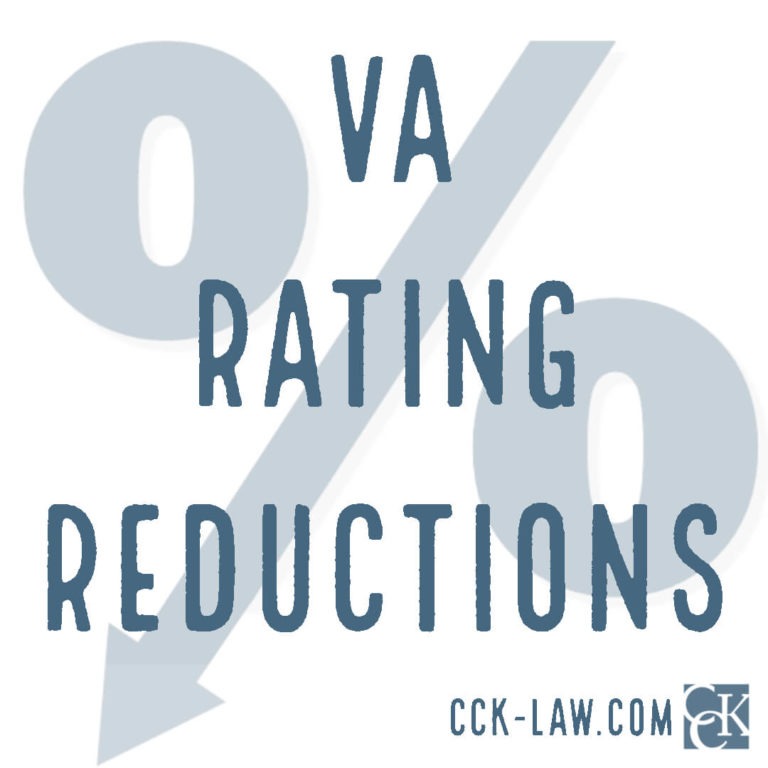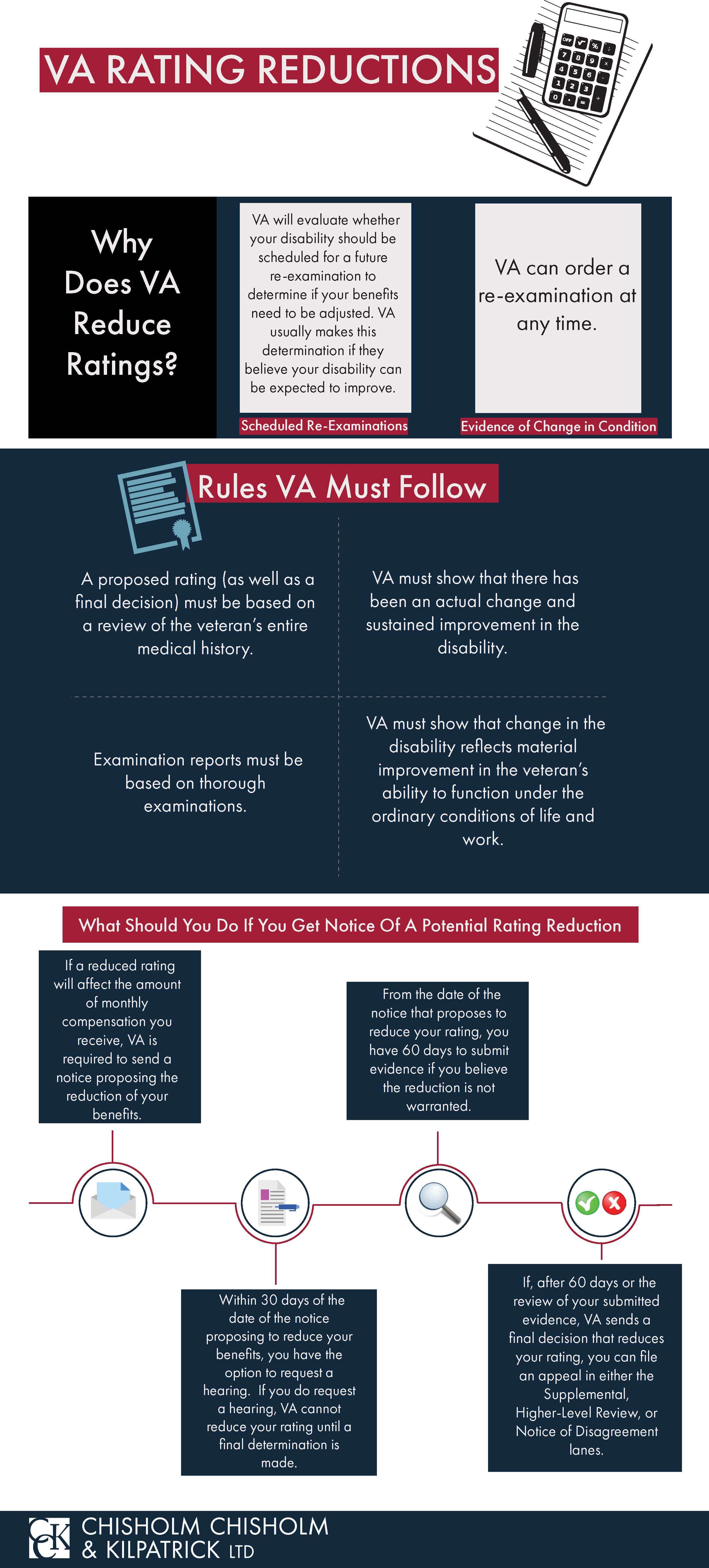What Happens When VA Proposes to Reduce My Disability Rating?

CCK Law: Our Vital Role in Veterans Law
When a veteran suffers from a service-connected disability, VA assigns them a disability rating between 0 and 100 percent. Veterans are paid a set monthly amount that corresponds to their combined disability rating based on VA compensation rates. In many cases VA is able to reduce a veteran’s rating and therefore the amount of compensation they receive each month. Throughout this post, we will be discussing why this occurs, VA’s process for implementing rating reductions, and what you can do to fight a proposed rating reduction.
Why Does VA Reduce Disability Ratings?
The Department of Veterans Affairs reduces veterans’ disability ratings to ensure that each veteran is being compensated for their current level of disability. If VA anticipates that a veteran’s condition has improved or will improve over time when initially rating them, they will schedule a re-evaluation of the veteran’s condition and can potentially reduce their disability rating.
The purpose of a re-evaluation is to ensure each veteran is being compensated at the proper amount for their condition’s current level of severity. The policy is intended to recognize that, in some instances, veteran’s conditions can improve. This, however, can result in a decrease in the veteran’s compensation level.

How Does VA Initiate the Rating Reduction Process?
There are two primary triggers for VA to initiate a rating reduction:
- New Evidence—If VA receives new evidence, such as medical records indicating a change in the veteran’s disabling condition, it will schedule an examination to evaluate the veteran’s current level of disability.
- Potential for Improvement—If VA saw potential for improvement in your condition when initially rating you, your decision will note that you are subject to future evaluations. If your disability is subject to re-evaluation, VA may reduce your rating following this second examination. Veterans must attend this exam if they wish to fight their proposed rating reduction, because if they do not attend, VA will likely reduce their disability rating.
In either of these scenarios, VA will most likely schedule the veteran for a new VA examination to ensure that the veteran’s condition is correctly evaluated. Importantly, VA may schedule an exam at any point during the reduction process. While some veterans may think that refusing to attend an exam could help prevent a reduction, the opposite is true. Failure to attend an exam or to follow through with scheduling an examination could result in a reduction even sooner. Therefore, it is crucial that veterans attend any scheduled C&P exams and contact VA as soon as possible if they do need to reschedule an exam.
It is also important for veterans to be honest during the exam regarding how the condition affects them under the ordinary conditions of life and work. To reduce a veteran’s rating, VA will need to demonstrate that there is actual improvement in the veteran’s condition and improvement in their functioning. Examples of this may include improvements in the veteran’s ability to walk around, to run everyday errands, or to care for themselves.
What Rules Must VA Follow to Reduce Ratings?
There are due process laws that VA must follow in order to reduce a veteran’s rating.
- VA Notifies the Veteran—To initiate a rating reduction, VA’s first step is to send a notice to the veteran that VA has proposed to reduce their rating. This notice is not a rating decision. You cannot appeal a proposed reduction using a Notice of Disagreement (NOD) as you would a rating decision.
- The Veteran Decides on a Hearing or Not—If a veteran does not agree with the proposed reduction, they have 30 days to request a hearing (although this step is not necessary to fight a reduction). If you do request a hearing, VA cannot reduce your rating until it is held. Requesting a hearing can provide the veteran with additional time to submit new evidence to fight the proposed reduction. Whether you request a hearing or not, veterans have 60 days to submit new evidence.
- VA Issues a Decision— In order for VA to issue a decision reducing a veteran’s rating, it must prove through medical evidence that there has been an actual change in the veteran’s disabling condition since they were last rated. In addition, there must have been improvement in the veteran’s condition using the evidence provided throughout the course of their entire medical history.
If VA issues a decision reducing a veteran’s disability rating, the veteran should follow the traditional appeals process by filing a Notice of Disagreement (NOD). Note that once VA has issued a decision reducing your rating, it will go into effect and your benefits will be impacted.
Specifically, this means that the veteran will likely receive less compensation starting the month following the date the decision was issued. If the veteran appeals the reduction, they may potentially have their rating restored and VA would then owe the veteran that money that was improperly reduced.
How to Fight a VA Rating Reduction
Upon receiving a proposal to reduce from VA, a veteran has 30 days to respond to this notice to request a hearing. Veterans are not required to request a hearing, however they can request one if they feel it would benefit them in some way. It also prevents VA from reducing the veteran’s rating until the hearing has been conducted.
Veterans may feel a hearing can be beneficial because it allows them to describe their condition to VA in their own words and explain how it may have not improved. Further, because of the length of time it can take to schedule a hearing, veterans often have the opportunity to gather the necessary evidence to fight the reduction. This also holds the current rating in place while the veteran, or veteran’s advocate, undergoes the process of collecting evidence to fight the reduction. This makes requesting a hearing an important procedural step a veteran may take.
Whether a veteran requests a hearing or not, they will have 60 days from the date of the notice to submit additional evidence in support of their current rating and show that a reduction is not warranted. This evidence can take several different forms.
Examples of Evidence to Fight a VA Rating Reduction
- Lay Evidence—Lay evidence may take the form of any statement from someone who witnesses the effects of your disability on your daily life. This could include a spouse, family member, co-worker, or any other person that knows the veteran well. Veterans themselves may also submit lay statements.
- Private Medical Opinions—Private medical opinions can be used to show that the veteran’s condition has not improved. Treatment records can also be very useful to indicate this lack of improvement.
What Happens if a Veteran Does Not Respond to a Proposed Rating Reduction?
If a veteran does not respond to the proposed reduction, or they do not receive a copy of the proposed reduction, or they respond but VA nevertheless issues a decision that finalizes the reduction, veterans do have the same rights to appeal the decision as they would for any other decision.
For example, if the decision is an AMA decision, the veteran would have three options: (1) submit new and relevant evidence in a supplemental claim lane appeal; (2) request a higher-level review in which a higher-level adjudicator at the VA Regional Office looks at the case; or (3) send the case to the Board by filing a Notice of Disagreement. Further, there are three dockets a veteran must choose between if they choose the Board option. Ultimately, the veteran may appeal a finalized decision that implements a reduction the same way that they might any other decision.
Are Certain Conditions More Vulnerable to Rating Reductions?
Yes. VA uses diagnostic codes when assigning your rating, some of which require re-examinations by nature. For example, VA often will attempt to reduce the ratings of veterans who suffer from cancer, as the cancer is expected to improve with treatment. Active cancer usually warrants a 100 percent disability rating, whereas someone who is in remission and only suffering from the cancer’s residuals may only be rated at 20 percent. However, if medical evidence shows that the cancer has not improved, your disability rating should not be reduced.
Are Some Ratings Protected from Being Reduced?
There are certain circumstances in which your disability rating is afforded certain protections:
- Stabilized ratings are for conditions that have been continuously rated for 5 years or more at the same disability level. In order for VA to reduce stabilized ratings, it must show that your condition has exhibited sustained improvement. The threshold of evidence is higher in this circumstance as VA cannot rely on only one C&P examination to implement the reduction of a stabilized rating.
- After the condition has been continuously rated for 10 years of more, there is an added layer of protection in that VA can no longer sever your condition. This means that VA can not take away service connection. They may still propose a reduction, however they cannot fully take away service connection unless they are able to prove that service connection was granted based on fraud.
- 100% Ratings may be reduced if VA can show that your condition has shown material improvement. Material improvement means that there has been a significant change in the veteran’s ability to function in daily life.
- Continuous Ratings are disability ratings assigned to conditions that have been either at or above the same level for 20 consecutive years. These are also referred to as “protected ratings.” After 20 years of a consecutive rating, VA may no longer propose to reduce the veteran’s rating for the condition below the lowest rating assigned during those 20 years. In other words, VA cannot reduce the veteran’s rating below the lowest possible rating they have previously received. The only way VA can reduce a continuous disability rating is by demonstrating that it was obtained by fraud.
- The 55 Year Rule applies to veterans over the age of 55. Specifically, it states that if you are 55 years old then federal guidelines dictate that you should be exempt from reexamination, except in rare circumstances or by regulation. For example, a VA regulation requires that they schedule re-examination for veterans who have completed treatment for certain cancers six months after they complete treatment. These guidelines also advise that VA not schedule a reexamination for a veteran who may be younger than 55 but who would be 55 by the future examination date.
- Permanent and Total disability ratings are assigned to veterans with totally disabling (100 percent) conditions that are not anticipated to improve over time. Veterans with Permanent and Total disability ratings should be protected from any future examinations for those conditions. Filing new claims could cause VA to investigate the conditions again, so it is important to be sure that any additional, future evidence submitted for an increased rating is relevant to securing an increased rating. To discern whether VA has awarded Permanent and Total disability ratings, veterans can look at the rating decision they received to find VA’s determination. If the rating decision states that the veteran will be scheduled for a re-examination, it indicates that the rating is not permanent and total.
About the Author
Share this Post

